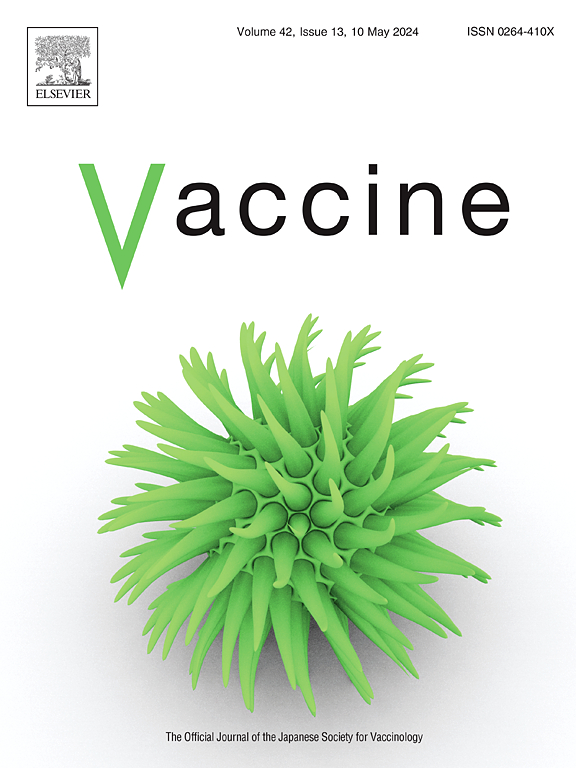Recombinant quadrivalent influenza vaccine (RIV) induces robust cell-mediated and HA-specific B cell humoral immune responses among healthcare personnel
IF 4.5
3区 医学
Q2 IMMUNOLOGY
引用次数: 0
Abstract
Egg-free influenza vaccines, specifically cell culture-based inactivated influenza vaccine (ccIIV) and recombinant influenza vaccine (RIV), represent a significant advancement over traditional egg-based inactivated influenza vaccines (IIV), particularly for populations with extensive vaccination histories. This comprehensive immunological study investigated the comparative efficacy of ccIIV, IIV, and RIV in healthcare personnel (HCP) with repeated vaccination histories, examining both cellular and humoral immune responses through multiple analytical approaches.
Our investigation employed a multi-faceted analytical framework, combining serological assessments via hemagglutination inhibition (HI) and microneutralization (MN) assays with detailed cellular immune response analysis. We utilized advanced flow cytometry techniques with recombinant hemagglutinin (HA) probes to evaluate both circulating T follicular helper cells (cTfh) and HA-specific B cells, providing a comprehensive view of vaccine-induced immune responses.
The results revealed RIV's superior immunogenicity profile, demonstrating significantly elevated levels of both cTfh and HA-specific B cells compared to ccIIV and IIV. RIV's enhanced performance was particularly evident in its response to influenza A components, with notably higher immunogenicity against both A(H3N2) and A(H1N1) strains. This superiority was reflected in elevated HI titers and markedly increased HA-specific B cell induction. While RIV also demonstrated enhanced HA-specific B cell responses against influenza B components compared to ccIIV, interestingly, HI titers remained comparable across all vaccine groups for these strains.
These findings underscore the critical importance of comprehensive immune response evaluation in vaccine assessment. The disparity between cellular and serological responses, particularly for influenza HA-specific B cells, highlights that traditional serological measures alone may not fully capture the breadth and depth of vaccine-induced immunity. This study provides compelling evidence for the inclusion of cellular immunity assessments in vaccine evaluation protocols, offering crucial insights into vaccine immunogenicity that may be missed by conventional serological analysis alone.
重组四价流感疫苗(RIV)在医护人员中诱导了强大的细胞介导和ha特异性B细胞体液免疫反应
无蛋流感疫苗,特别是基于细胞培养的灭活流感疫苗(ccIIV)和重组流感疫苗(RIV),代表了传统的基于蛋的灭活流感疫苗(iv)的重大进步,特别是对于有广泛疫苗接种史的人群。这项综合免疫学研究调查了ccIIV、IIV和RIV在有重复疫苗接种史的医护人员(HCP)中的比较疗效,通过多种分析方法检查了细胞和体液免疫反应。我们的研究采用了多方面的分析框架,结合血清学评估,通过血凝抑制(HI)和微量中和(MN)测定和详细的细胞免疫反应分析。我们利用先进的流式细胞术技术和重组血凝素(HA)探针来评估循环T滤泡辅助细胞(cTfh)和HA特异性B细胞,为疫苗诱导的免疫反应提供了一个全面的视角。结果显示RIV具有优越的免疫原性,与ccIIV和IIV相比,RIV的cTfh和ha特异性B细胞水平显著升高。RIV的增强性能在对甲型流感成分的反应中尤为明显,对甲型H1N1和甲型H3N2病毒株的免疫原性都显著提高。这种优势反映在HI滴度的升高和ha特异性B细胞诱导的显著增加上。虽然与ccIIV相比,RIV也表现出增强的ha特异性B细胞对乙型流感成分的反应,但有趣的是,这些毒株的所有疫苗组的HI滴度仍然具有可比性。这些发现强调了在疫苗评估中综合免疫反应评价的重要性。细胞反应和血清学反应之间的差异,特别是流感ha特异性B细胞的差异,突出表明传统的血清学措施可能无法完全捕捉疫苗诱导免疫的广度和深度。这项研究为将细胞免疫评估纳入疫苗评估方案提供了令人信服的证据,为疫苗免疫原性提供了重要的见解,而传统的血清学分析可能会遗漏这一点。
本文章由计算机程序翻译,如有差异,请以英文原文为准。
求助全文
约1分钟内获得全文
求助全文
来源期刊

Vaccine
医学-免疫学
CiteScore
8.70
自引率
5.50%
发文量
992
审稿时长
131 days
期刊介绍:
Vaccine is unique in publishing the highest quality science across all disciplines relevant to the field of vaccinology - all original article submissions across basic and clinical research, vaccine manufacturing, history, public policy, behavioral science and ethics, social sciences, safety, and many other related areas are welcomed. The submission categories as given in the Guide for Authors indicate where we receive the most papers. Papers outside these major areas are also welcome and authors are encouraged to contact us with specific questions.
 求助内容:
求助内容: 应助结果提醒方式:
应助结果提醒方式:


